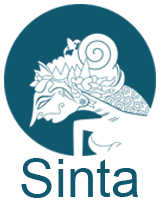Identification of Flavonoid Compounds in Clove Leaves (Syzygium aromaticum (L.) L.M. Perry) Using Thin Layer Chromatography Method
Abstract
Clove (Syzygium aromaticum (L.) L.M.Perry) is a plant that has been used for centuries in traditional medicine for many ailments. Clove leaves contain saponins, tannins, alkaloids, glycosides and flavonoids. Flavonoids are phenolic compounds that can change color when a base or ammonia is added so they are easily detected using thin layer chromatography. Identification of flavonoid compounds contained in clove leaves (Syzygium aromaticum (L.) L.M.Perry) was carried out using the thin layer chromatography method. This research is intended to identify the flavonoid content in clove leaves. The method used to identify flavonoids from the flavones, flavonols, glycoflavones and biflavonyl groups uses thin layer chromatography.
The organoleptic results of clove leaf simplicia have a brownish green color, a distinctive pungent odor, and are in the form of a rather fine powder. Flavonoid phytochemical screening had positive results indicated by the presence of an orange color on the amyl alcohol layer. Then the clove leaf simplicia was prepared for testing using thin layer chromatography by heating using 2N HCl at a temperature of 100 oC and extracted with ethyl acetate then spotted on a thin layer chromatography plate. The organoleptic results of the clove leaf extract had a reddish brown color, with a sticky texture and no smell. Examination of clove leaf extract (Syzygium aromaticum (L.) L.M.Perry) using thin layer chromatography, this elution was carried out using an acidic eluent, showing that clove leaves were positive for flavonoids in the flavon group which showed a faint brown color with Rf 0.66 and 0,70 and negative for flavonoids in the flavonol, glycoflavone and biflavonyl groups because the Rf value and stain color do not match comparisons in the literature.
Keywords
Full Text:
PDFReferences
Ahmad Dwi Setyawan, 2008. Biflavonoid compounds of Selaginella Pal. Beauv. and its benefit. Universitas Sebelas Maret (UNS) Surakarta.
Harborne, J., B. 1996. Metode Fitokimia: Penuntun Cara Modern Menganalisa Tumbuhan Terbitan Kedua. Terjemahan Kosasih Padmawinata dan Iwang Soediro. ITB: Bandung.
Heinrich, M., Barnes, J., Gibbons, S., Williamson, E., M. 2010. Farmakognosi dan Fitoterapi. Penerbit Buku Kedokteran: Jakarta.
Markham, K.,R. 1988. Cara Mengidentifikasi Flavanoid. Terjemahan Kosasih Padmawinata, Penerbit ITB: Bandung.
Miller, A., L. 1996. Antioxidant Flavonoids: Structure, Function and Clinical Usage. Alt. Med. Rev. 1(2).
Nurbaety B, Safwan, Haeroni AN. Uji Daya Hambat Ekstrak Daun Cengkeh (Syzygium aromaticum) Terhadap Bakteri Escherichia coli Dengan Menggunakan Metode Sumuran. Jurnal Insan Farmasi Indonesia.2018.
Nurdjannah, N. 2004. Diversifikasi Penggunaan Cengkeh. Perspektif Volume 3 nomor 2.
Taher DM, Solihin DD, Cahyaningsih U, Sugita P. Ekstrak Metanol Cengkeh (Syzygium aromaticum) Varietas Tuni Buru Selatan Sebagai Antimalaria Acta Veterinaria Indonesiana. 2018:6(2): 38-47.
Wahyulianingsih, Selpida. 2016. Penetapan Kadar Flavonoid Total Ekstrak Daun Cengkeh (Syzygium aromaticum (L.) Merr & Perry). Fakultas Farmasi, Universitas Muslim Indonesia.
Wulandari, Lestyo. 2011. Kromatografi Lapis Tipis, Jember : PT. Taman Kampus Presindo.
DOI: https://doi.org/10.31764/jafp.v5i1.31376
Refbacks
- There are currently no refbacks.
Copyright (c) 2025 Endah Ratnasari Mulatasih, Eliza Choirun Nisa, makhdalena makhdalena, Ani Hartati, Ageng Hasna Fauziyah

This work is licensed under a Creative Commons Attribution-ShareAlike 4.0 International License.
JAFP is indexing in the following databases:











